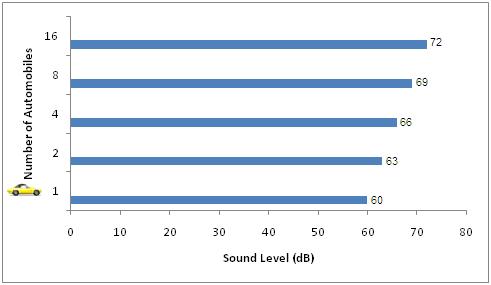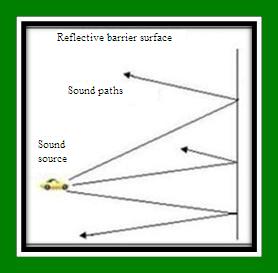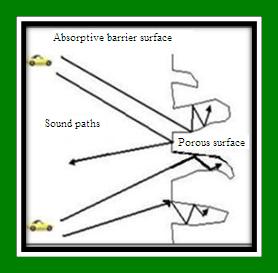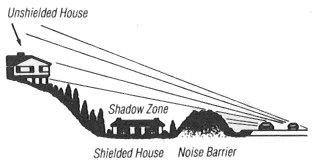Sound Barriers Guidelines - Highway Traffic Noise
To inquire about noise abatement, go to the New Service Request Page; in the Topic section, select Sound Barrier from the pull-down menu. Pick a sub-topic, then explain your request in the Description box.
Sound and Noise
Sound is created when an object moves. This movement causes vibrations and waves in air molecules, like ripples in the sea. When the vibrations reach our ears, we hear sound. Noise is unwanted sound. It is a pollutant and a hazard to human health and hearing. Noise levels are measured in decibels. The decibel (dB) is a unit that expresses the ratio of the sound pressure level being measured to a standard reference level. The higher the decibel level, the louder the noise. Sounds louder than 80 decibels harm the human ear. The noise chart below gives an idea of average decibel levels for everyday sounds around you.
Common Noise Sources
| Outdoor Noise Sources |
Noise Level (Decibels) |
Indoor Noise Sources |
|
|
110 |
Rock Band |
| Jet Flyover at 1,000 Feet |
100 |
Inside Subway Train (NY) |
| Gas Lawn Mower at 3 Feet |
|
|
| Diesel Truck at 50 Feet |
90 |
Food Blender at 3 Feet |
| Noisy Urban Daytime |
80 |
Garbage Disposal at 3 Feet, Shouting at 3 Feet |
| Gas Lawn Mower at 100 Feet |
70 |
Vacuum Cleaner at 10 Feet |
| Commercial Area |
|
Normal Speech at 3 Feet |
|
|
60 |
|
|
|
|
Large Business Office |
| Quiet Urban Daytime |
50 |
Dishwasher, Next Room |
| Quiet Urban Nighttime |
40 |
Small Theater, Large Conference Room (Background) |
| Quiet Suburban Nighttime |
|
Library |
|
|
30 |
|
| Quiet Rural Nighttime |
|
Bedroom at Night, Concert Hall (Background) |
|
|
20 |
|
|
|
|
Broadcast and Recording Studio |
|
|
10 |
Threshold of hearing |
|
|
0 |
|
Note:
- The loudness of traffic noise is generally increased by proximity to the highway, heavier traffic volume, higher speed, and a large number number of trucks.
- Vehicle noise is a combination of the noise from the engine, exhaust, and tires.
- Defective mufflers and other faulty vehicle parts can also increase the loudness of traffic noise.
- Any condition, such as a steep incline, that causes heavy laboring of motor vehicle engines will also increase traffic noise levels.
Source: FHWA Website on Highway Traffic Noise
Understanding the Effect of Traffic Volume Changes on Noise Levels
In general, an increase in traffic volume causes increased noise levels. However, the amount of increase in noise depends on the relative increase in traffic volume as shown in the chart below:

- The average person can just begin to perceive a change in noise level when there is an increase of at least 3 decibels.
- As the chart above shows, each time the number of vehicles doubles, overall noise level increases by 3dBA.
- This effect occurs regardless of the actual number of vehicles in traffic. For example, if a highway carrying 5,000 vehicles per hour produces an overall noise level of 80 dBA, the traffic volume must increase to 10,000 vehicles per hour for the overall noise level to increase by 3 to 83 dBA.
In conclusion, change in noise level is perceptible only when considerably more vehicles join traffic. This condition is often reported in noise impact studies for projects to widen existing highways, especially those with already substantial traffic volumes.
Source: SHA Travel Forecasting
Reducing the Impact of Traffic Noise
The Maryland Department of Transportation State Highway Administration (MDOT SHA) reduces noise levels for communities through:
-
Land Use Control Sometimes, concerns about highway traffic noise come from occupants of new homes built adjacent to an existing highway. Many of these highways were originally constructed through undeveloped lands. Prudent land use control can help to prevent many future traffic noise problems in these areas. MDOT SHA works with local jurisdictions and legislators throughout Maryland to develop statutes that limit the building of noise-sensitive homes, offices, and houses of worship adjacent to existing highways.
-
Highway Planning and Design Early in the planning stages of most highway improvements, MDOT SHA performs a noise study. The purpose of this study is to determine if the project will create any noise problems. First, the existing noise levels of a highway are measured or computed by models. Then, engineers predict noise levels if the project is constructed. If the predicted noise levels will exceed State noise criteria, the State considers measures to lessen this loud noise. Most times, sound barriers are used for noise abatement.
Sound Barriers
A sound barrier is a solid obstruction built between the highway and the homes along the highway to reduce the loudness of
highway traffic noise. These barriers can be constructed from earth mounds or berms, concrete, masonry, wood, metal, and other materials. The material is selected based on aesthetics, durability, maintenance, cost, and public input.
Sound barriers:
- considerably reduce noise levels for people living next to highways.
- can reduce the loudness of traffic by as much as half.
- do not totally block all traffic noise.
- are most effective within 200 feet of a highway.
- can be effective, regardless of the material used.
Maryland Sound Barrier Programs
MDOT SHA
Sound Barrier Policy guides engineers who evaluate traffic noise and noise abatement opportunities for communities adjacent to state highways. This policy was adopted with the approval of the Federal Highway Administration (FHWA) and meets provisions of the federal regulations (23 CFR 772), which require states to adopt their own policies on the abatement of highway traffic noise. MDOT SHA’s policy applies to projects funded with federal and/or State funds, and projects funded by approved third parties for maintenance and functional or aesthetic enhancements. In the State of Maryland, sound barriers are evaluated in two separate categories:
-
Sound barrier construction is considered when a new highway is being constructed or an existing state-maintained highway is expanded.
-
This is a voluntary program. Sound barrier construction is considered for existing highways where the impacted development was built prior to the approval of original construction of the highway. Implementing a Type II project is an optional decision by the State — implementation of Type II projects is not a federal requirement.
How Does a Sound Barrier Program Work?
Sound barriers reduce the noise that enters a community from a highway by absorbing, reflecting, or forcing the sound to take a longer path over and around the barrier. Sound is energy that decreases in intensity as it travels away from its point of origin. Sound waves travel in all directions from vehicles on the roadways. When sound waves encounter an obstacle or barrier, some of the sound bounces off the barrier's surface (reflective surface). If the surface is porous, where there are small cavities or holes that extend into the interior of the barrier material, some of the sound waves travel inside the cavities after they reach the surface. The waves bounce around and eventually expend their energy. This process is called absorption.


A noise barrier can achieve a 5 decibel (dBA) noise level reduction, when it is tall enough to break the line-of-sight from the highway to the home or receiver. After it breaks the line-of-sight, it can achieve approximately 1.5 decibels of additional noise level reduction for each meter (about three feet) of barrier height. To effectively reduce the noise coming around its ends, a barrier should be at least eight times as long as the distance from the home or receiver to the barrier.
Source: FHWA Website
MDOT SHA determines the height of proposed barriers using acoustic profiles (noise measurement equipment collects noise data, then displays and maps it so that a 7 to 10 decibel noise level reduction can be achieved. There are no standard barrier heights since each project site has different topography.
When a Sound Barrier is Not the Answer
Sound barriers do have limitations and are not always an effective noise abatement method. To determine if the construction of a sound barrier will provide a reasonable noise level reduction, both the distance of the impacted community from the roadway and the topography of the area are considered. Role of Distance Typically, the primary impacted residences (which we also refer to as first row residences) are within 100 to 200 feet of the roadway. Second row residences, which are often impacted, are usually a next-door neighbor or located across the street from a first row residence. As noise impacts and potential noise abatement methods are evaluated past second row residences, it is difficult to provide effective abatement. A sound barrier is not likely to reduce noise levels for residents who live far from the roadway.
Role of Topography To work effectively, the barrier must be high and long enough to block the view of the road from the area to be protected. Sound barriers do very little for homes on a hillside overlooking a road.

Source: FHWA Website
As seen above, the house at the bottom of the hill is protected by the sound barrier, but the one on top of the hill overlooking the roadway is not. Buildings higher than barriers, homes scattered far apart, and openings in noise barriers for driveways or intersecting streets are not good areas for sound barriers. In some cases, MDOT SHA can offer alternatives to reduce noise levels. These alternatives are evaluated on a case-by-case basis consistent with federal guidelines.
Highway Traffic Noise Inquiries
Review
Type I and
Type II programs to learn more about our policy on noise abatement.
To submit a highway traffic noise inquiry, complete the
online form. We will investigate and respond.
For more information
Additional questions? Contact the Office of Highway Development (OHD) at 1-888-228-5003.